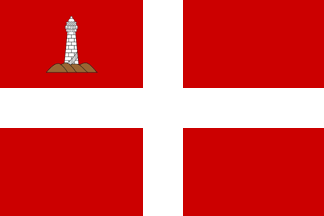 image
by Clay Moss, 04 Nov 2007
image
by Clay Moss, 04 Nov 2007Club Flag - The club flag shall be a rectangular red flag with a white cross with a white lighthouse in the upper canton next to the staff.

FOTW beschäftigt sich mit der Wissenschaft der Vexillologie (Flaggenkunde).
Alle auf dieser Website dargebotenen Abbildungen dienen ausschließlich der Informationsvermittlung im Sinne der Flaggenkunde.
Wir distanziert uns ausdrücklich von allen hierauf dargestellten Symbolen verfassungsfeindlicher Organisationen.
Last modified: 2017-11-11 by bruce berry
Keywords: national index | south africa | point yacht club | royal cape yacht club | royal natal yacht club |
Links: FOTW homepage |
search |
disclaimer and copyright |
write us |
mirrors
The present constitution of the Point Yacht Club was adopted in 1882 and laid
down the following Club flags:
 image
by Clay Moss, 04 Nov 2007
image
by Clay Moss, 04 Nov 2007
Club Flag - The club flag shall be a rectangular red flag with a white cross
with a white lighthouse in the upper canton next to the staff.
Club Burgee - The club burgee shall be a red pennant with a white cross with a white lighthouse in the upper canton next to the staff.
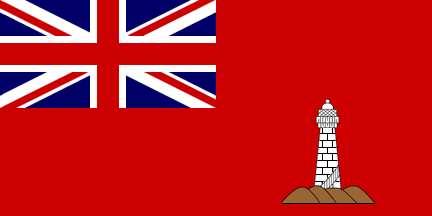 image
by Clay Moss, 04 Nov 2007
image
by Clay Moss, 04 Nov 2007
In a letter dated 19 April 1937, the Under Secretary of State in the Dominions
Office in London advised the South African High Commissioner that the Admiralty
had approved the application of the Point Yacht Club for permission to use a red
ensign defaced with the badge of the Club, namely a white lighthouse standing on
brown rocks, in the lower fly. The decision to grant this Club a defaced red
ensign might have been taken to obviate any confusion with the defaced blue
ensign of the Commissioners of Northern Lighthouses
which is also defaced by a light-house, but could have also have
been influenced by the fact the Club's flags were predominantly red.
South Africa left the British Commonwealth on 31 May 1961 and in 1973 the Point
Yacht Club ceased to be listed as a Privileged Yacht Club (Source: SAVA Journal 3/94: The Union Jack over Southern and Central Africa, 1795
- 1994 [brl94] by FG Brownell).
Bruce Berry, 04 Nov 2007
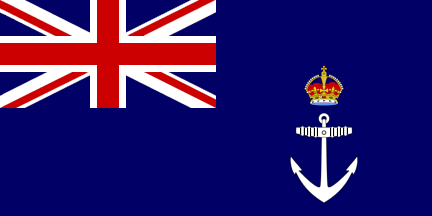 image
by Clay Moss, 03 Nov 2007
image
by Clay Moss, 03 Nov 2007
In March 1914 the newly-named Cape Yacht Club, whose predecessor had been the
Table Bay Yacht Club, applied for a Royal Warrant. In reply to this request the
Governor-General advised the Club that His Majesty the King was "graciously
pleased to approve the title Royal to the Cape Yacht Club". On 26 June 1914, the
Governor-General, Viscount Gladstone, approved a recommendation that an
Admiralty Warrant be issued authorizing the use of a plan blue ensign, but then
World War I intervened.
After the end of the War, during which all Admiralty Warrants for privileged
Yacht Club Ensigns were suspended, the Club applied for, and was granted,
the privilege of a Blue Ensign defaced in the lower fly with a white anchor
ensigned with a Tudor Crown proper. Members of the Club who wished to avail
themselves of this privilege had to make application through the Club. Warrants
were again suspended during World War II.
The Club's defaced blue ensign was flown from the flagstaff at the Clubhouse
until 1966. At that time only three members were authorized to wear it on their
yachts. South Africa had by that time left the Commonwealth and a special
meeting of the Club resolved that the ensign should be replaced by the South
African national flag. The Warrant was duly returned to the Admiralty (Source:
SAVA Journal 3/94: The Union Jack over Southern and Central Africa, 1795
- 1994 [brl94] by FG Brownell).
The Club burgee is triangular, per pale red and blue, charged on the red with a
white anchor ensigned with a Tudor Crown proper. The burgee has a narrow border
around the edges.
Bruce Berry, 03 Nov 2007
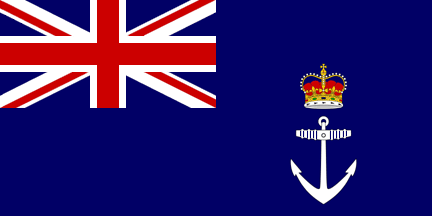 image
by Clay Moss, 03 Nov 2007
image
by Clay Moss, 03 Nov 2007
As a matter to note, I have been in contact with the RCYC's Commodore, and the
Club is currently in the process of getting their warrant to utilize their
ensign reinstated. I have prepared the above image" to show what a new ensign
might look like with a (modern) St. Edward's crown.
Clay Moss, 03 Nov 2007
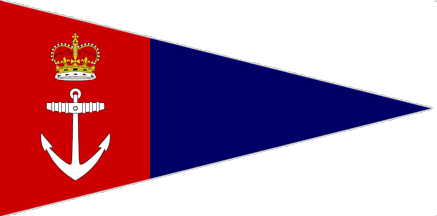 image by Peter Hans van den Muijzenberg, 12 June 2014
image by Peter Hans van den Muijzenberg, 12 June 2014
A variant of the RCYC burgee with a white anchor has been put on auction on eBay.
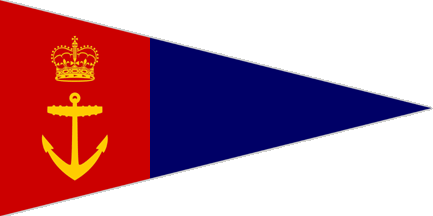 image by Clay Moss, 03 Nov 2007
image by Clay Moss, 03 Nov 2007
The Constitution of the Club can be found on its
website, which says:
"16. CLUB INSIGNIA
The Club flag shall consist of a red burgee with a blue fly with a white hanging
anchor surmounted by a gold crown superimposed on the burgee: an example of
which shall be retained with the Club records for reference purposes. ..."
So, Clay's image matches the constitution, in that it has a white anchor. This
is somewhat curious, as Clay has been in contact with the RCYC before he drew
his 2007 image, which shows a golden anchor, and they apparently verified the
drawing. I wonder what that reference specimen retained with the club records
actually looks like?
The
merchandise pages do show a burgee. Here the emblem is considerably
more abstract than in Clay's images. It also has a rather bland golden anchor,
instead of the characteristic anchor in Clay's images that makes the burgee so
instantly recognisable. I don't know how official it is, but we may have
to document and
illustrate it as a separate design/variation.
The constitution lists flag officer's positions, but it doesn't elaborate on
whether "flag" is to be taken literally, with these officers having specific
flags, different from the burgee.
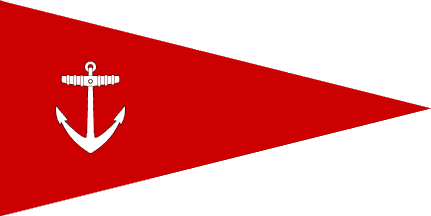 image by Peter Hans van den Muijzenberg, 31 May 2015
image by Peter Hans van den Muijzenberg, 31 May 2015
The club's history
page, gives more information on the Table Bay Yacht Club as well. As I read it,
the Table Bay Yacht Club was founded in 1905 and existed until 1914, when it
merged with the Alfred Rowing Club to form the Cape Yacht Club.
The TBYC's flag is illustrated as a red burgee with a white anchor. (This
suggests the Alfred Rowing Club brought in the blue fly, but that's not
mentioned or illustrated.) The problem with all that is that there's still an
Alfred Rowing Club in the Cape Town area, with a history older than that of the
RCYC, so I may have misunderstood.
The history page then continues with the mention that shortly afterwards, the
Cape Yacht Club received a Royal Charter. As one would assume that the crown was
added to the burgee once the club became "Royal", it would seem likely that for
the short - yet unspecified - while as the Cape Yacht Club, the club used a
burgee without a crown.
Peter Hans van den Muijzenberg, 12 June 2014
The club's early records are held by the Western Cape Archives & Records Service
(WCARS). I recently had an opportunity to look at them, and this is what
emerged in connection with the flags :
The original Table Bay Yacht Club burgee was red with a white anchor in the
hoist. The index to the minutes refers to resolutions about a burgee on 09
April, 02 May and 18 May 1905 but, unfortunately, the Minute Book for 1905 is
not there, so it's not clear on which of those dates the design was actually
approved.
The club was renamed 'Cape Yacht Club' in January 1914, as it no longer wanted
to confine itself to Table Bay. The 'Royal' title was approved in May
1914, and the burgee was then changed. The committee resolved on 16 June
1914 that "the flag selected displayed next the shaft the white anchor on a red
field of the old Table Bay Yacht Club with a crown in yellow above the anchor
and a 'fly' of blue" [WCARS : A 2568 Vol 1/1/1/2].
The privileged ensign was acquired in 1920. On 20 April 1920, the
commodore reported to the committee that he had approached the Admiralty and
received a favourable reply. The options were a plain Blue Ensign or a
Blue Ensign defaced with the club badge. The committee decided to adopt the
latter [WCARS : A 2568 Vol 1/1/1/3].
The files contain a copy of a Warrant issued to one of the members in 1921. As a
matter of interest, the wording was :
"This is to certify that the Lords Commissioners of the Admiralty have been
pleased, by virtue of the power and authority vested in them, to authorise the
Blue Ensign of His Majesty's Fleet with the distinguishing marks of the Club
thereon to be worn on board the "....." being a British vessel registered in
accordance with the Merchant Shipping Act 1894, provided that the Ensign shall
not without the consent of Their Lordships in writing be worn on board the
"....." while that vessel is lent on hire or otherwise to any person who is not
a member of the ..... Yacht Club, or who, being a member of the Club is not a
natural born or naturalised British subject" [WCARS : A 2658 Vol 2/1 File 1].
Arthur Radburn, 30 Sept 2014
In 1914, the crown would have been the Tudor crown
rather than the post-1952 St. Edward's crown.
Arthur Radburn, 31 May 2015
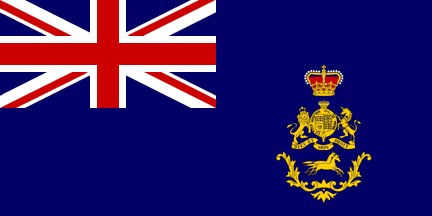 image
by Clay Moss, 02 Nov 2007
image
by Clay Moss, 02 Nov 2007
The Royal Natal Yacht Club had its origins in the Natal Yacht Club which was
founded in 1858 and on which the title "Royal" was conferred on 17 February
1891.
An Admiralty Warrant was issued on 15 May 1894 for a distinctive blue ensign,
bearing in the fly "The Natal Arms surmounted by a crown" for use by the Royal
Natal Yacht Club. The device in the fly is a slightly simplified version of that
depicted in the Natal colonial seal, excluding the circumscription. It is mainly
gold (yellow), with some white detail in the upper crown and in the oval shield
of the Royal Arms, while the cap and jewels of the upper crown are red. The
placing of the device directly on the
blue field ensured that this Ensign would not be confused with the Natal Blue
Ensign, with which it otherwise bears a striking similarity.
This privileged ensign has been in use for more than a century and unlike the
other South African privileged yacht ensigns of the Royal Cape and Point Yacht
Clubs, it was not relinquished after South Africa left the Commonwealth on 31
May 1961 (Source: SAVA Journal 3/94: The Union Jack over Southern and
Central Africa, 1795 - 1994 [brl94] by FG Brownell).
The Club burgee, which is also in current use, bears on a triangular white field
a blue cross fimbriated in red, with the Royal Crown proper in the canton.
Bruce Berry, 02 Nov 2007
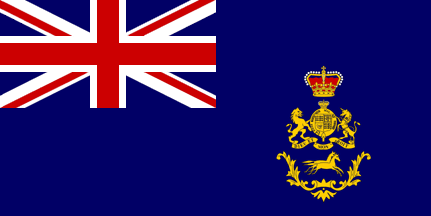 image by Clay Moss, 02 Nov 2007
image by Clay Moss, 02 Nov 2007
This posting marks the first time that I have sparked a club initiated change in
their ensign. Apparently, nobody has bothered to draw up the RNYC ensign or the
badge in quite a while. The above illustration represents the club's original
ensign. When I submitted this to the club for their critique, I
did so not realizing that the UK's Coat-of-Arms had changed slightly over the
past 100 plus years. Evidently, in 1894, the lion faced dexter or to the
observer's right towards the fly end of the ensign, and was not wearing a crown.
In the current UK Arms, the lion faces the observer and is wearing a crown (top
image).
Anyway, I submitted an RNYC ensign with a the current version of the Coat -of
-Arms. Needless to say that RNYC's officials realised the error. However,
they liked what I had done, and in their next board meeting, changed their
defacement to reflect the current version of the UK Arms.
Among other things, this means that the new badge will have three royal crowns on
it. One on the lion's head, one topping off the CoA, and the big crown over
everything. As a matter to note, while the lion's crown and the crown on top of
the Arms will be "modern day St. Edward's" in style, the big crown over all will
be the old Victorian style St. Edward's crown, reflecting the fact that the club
gained its royal status during Queen Victoria's reign.
The RNYC's Commodore and I discussed the fact that the RNYC's defacement is in
fact the most complex defacement in the British ensign 'universe' and could do
with a good overhaul. Simultaneously, the club takes a measure of pride in
having the most complex badge and had no plans to make a change beyond
recognizing the changes in the British Coat-of-Arms.
I reckon until supplies are exhausted, both ensigns illustrated above can be
recognized as "official" RNYC ensigns, although the top version is now
correct.
Clay Moss, 02 Nov 2007
The date is not that of the original warrant. In 1893 the British consul in Nice
had asked the Board of Trade whether a British yacht that had been lent to an
American
could fly the US flag. It was decided that Section 105 of the Merchant Shipping
Act of 1854 was not concerned with temporary hiring or giving of a yacht, only
with the
intentional concealment of national character, and therefore a foreign flag
could be flown on a British vessel loaned or hired to a foreigner.
As a result the warrants for special ensigns that had been issued to yacht clubs
were amended to include;
"The ensign shall not without our authority in writing be worn on board a vessel
belonging to the ..........Yacht Club while such vessel is lent, on hire or
otherwise, to any person not being a member of the club, or, when being a member
of the club, is not a natural born or naturalised British subject."
All existing warrants were cancelled and new warrants issued, all with the date
15 May 1894. [National Archives (PRO) MT 9/471].
In the 1892 edition of Lloyd's Yacht Register the Royal Natal is listed as
having a special ensign, and it is likely that the original warrant was issued
at about the same
time that the title 'Royal' was granted in February 1891.
David Prothero, 03 Nov 2007
Hosted by: Fanshop-Online.de und Handy-Shop.de
Tipp: Apple iPhone 8